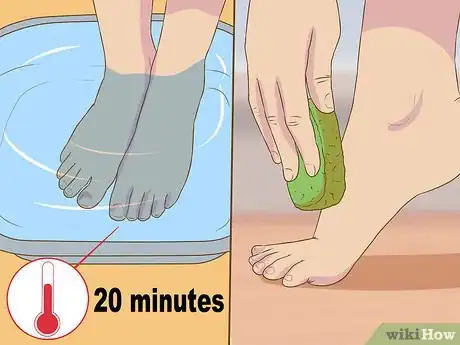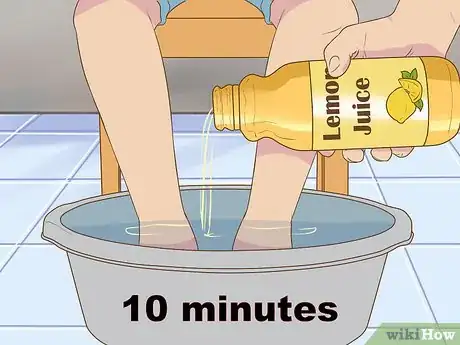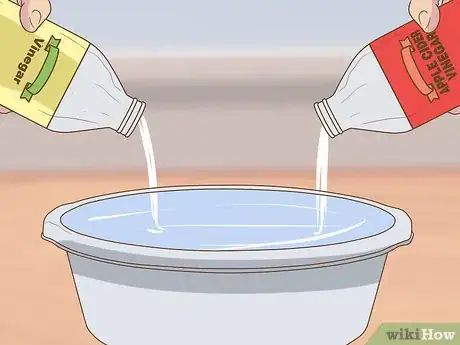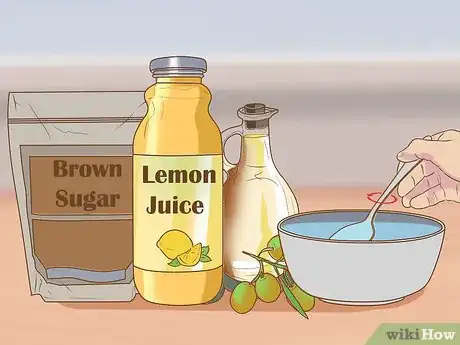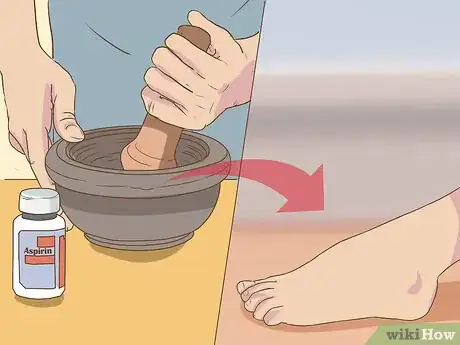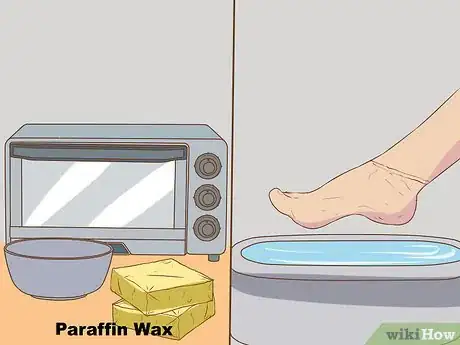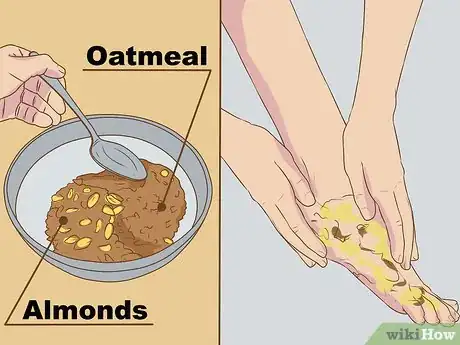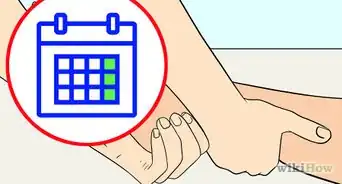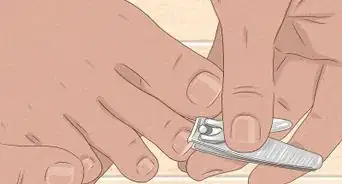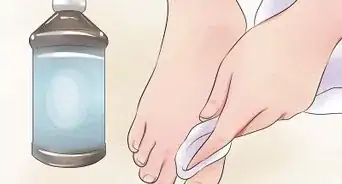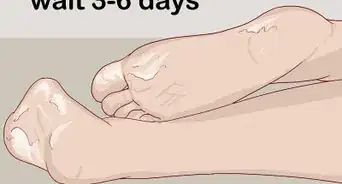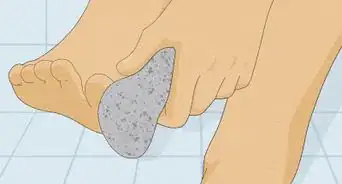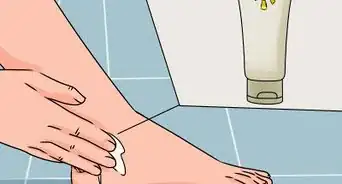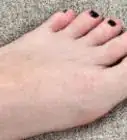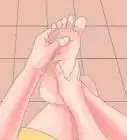This article was co-authored by Mark Co, DPM. Dr. Mark Co is a Podiatrist who runs his own private practice in San Francisco, California. Dr. Co specializes in treatments for bunions, ingrown toenails, toenail fungus, warts, plantar fasciitis and other causes of foot pain. He also offers custom orthotics for the treatment and prevention of foot and ankle issues. Dr. Co completed a Master of Business Administration (MBA) at New York University and an MA in Electrical Engineering and Computer Science at Johns Hopkins University. Dr. Co also completed his DPM at the California School of Podiatric Medicine and a residency and internship at the Kaiser Permanente Medical Center, Santa Clara, California. Dr. Co was awarded San Francisco's "Top 3 Podiatrists" in 2018, 2019, and 2020. Dr. Co is also a member of the CPMA (American Podiatric Medical Association).
There are 11 references cited in this article, which can be found at the bottom of the page.
This article has been viewed 386,531 times.
If your feet are looking a little worse for wear lately, we have good news. Removing dead skin from your feet is really simple, and you have a lot of different options you can try. Scrubs, soaks, and overnight treatments can all help restore your feet to their smoothest, softest state. Check out our tips below to learn how!
Steps
Soaking Your Feet
-
1Soak your feet in warm water and scrub. One of the most basic solutions is to soak feet for long enough to soften the dead skin and scrub it off with a pumice stone or foot brush. Fill a foot bath or small tub with enough water to cover the tops of your feet and soak for 20 minutes. Gently scrub the dead skin off of your feet.[1]
- This is most effective for broad, shallow calluses, like the ones that form on the heel of your feet.[2]
- This is best done gently because you don’t want to expose too much raw skin or your feet will hurt. Scrub a little off at a time and repeat over the course of a few days.
- Thickened skin is often due to calluses from pressure or friction on your feet, but shaving it down will prevent that callus from hurting the skin underneath.[3]
-
2Prepare a lemon juice soak. In a small plastic tub, pour enough lemon juice to cover the bottoms of your feet. If you don’t have enough lemon juice for this, it is okay to dilute with an equal amount of warm water. Soak for ten minutes then rinse and pat dry.[4]
- Undiluted lemon juice will give your feet a stronger treatment than if you dilute it with water.
- Make sure you don’t have any cuts or open sores on your feet as the acid in lemon juice will cause extreme burning in those areas.
Advertisement -
3Make an Epsom salt foot bath. Fill a foot bath, or small plastic container, half-full with warm to slightly hot water. Add a half cup (118.3 ml) of Epsom salt to the water. Soak feet for 10 minutes. Gently rub with a pumice stone to remove dead skin that the soak has loosened.[5]
- The works best if you repeat it every two to three days to avoid feet becoming dry again. It may take a few days of soaks to notice a big difference in the skin on your feet.
-
4Harness the power of vinegar. The acidic nature of both white vinegar and apple cider vinegar makes them great for removing dead skin. In a foot bath, or small plastic tub, mix equal parts vinegar and mild hot water. For the best results, soak feet for around 45 minutes and gently rub with a pumice afterward.[6]
- Another way to use this solution is to soak your feet in the vinegar and water mixture for about five minutes and then soak in pure apple cider vinegar for 15 minutes. This makes for a stronger soak than diluted vinegar.
Applying Foot Pastes
-
1Mash a banana and rub it on your feet. Make sure you use bananas that are as ripe as possible, almost to the point of being too ripe to eat. Place one or two bananas in a bowl. Use a fork or masher to mash then into a smooth paste. Apply to feet and leave it for about 20 minutes. Then rinse your feet clean.[7]
- Make sure you keep your feet off of the ground and furniture. Try propping them up on a footrest for the duration. It might also be smart to have a small tub of water handy so you can easily wash them off when you are done.
-
2Mix lemon juice, olive oil, and brown sugar. Combine 1 tbsp (14.8 ml) of lemon juice (about half of a fresh lemon), with 2 tbsp (29.6 ml) of olive oil and 2 tbsp (29.6 ml) of brown sugar. Mix thoroughly until a paste forms. Massage onto feet for 2-3 minutes and then let it remain on your feet for 15 minutes. Rinse the mixture off of your feet.[8]
- For continuing soft feet, perform this ritual on a weekly basis.
- Make sure you sit somewhere comfortable where you can keep your feet propped up for the whole time.
-
3Apply a crushed aspirin mixture to your feet. Crush 5-6 non-coated aspirin with a mortar and pestle, if you have one, or in a small zip style bag with the back of a spoon. Pour the aspirin powder into a bowl and add ½ tsp (2.5 ml) of water and ½ tsp (2.5 ml) of lemon juice. Mix together. Apply to feet and let it stay there for about 10 minutes. Rinse clean.[9]
- The mixture may want to run off of your feet, so consider wrapping a warm towel around each foot to help keep the mixture in place.
- Once your feet are rinsed clean, you can gently buff each foot with a pumice stone for dead skin removal.
Applying Overnight Treatments
-
1Coat each foot in paraffin wax. Paraffin wax is often used in beauty products to moisturize skin. Heat some in a microwave-safe bowl. Once heated, carefully pour onto a plate, or pan, large enough to fit your foot on. Gently place each foot into the wax. Allow wax to stiffen and place a sock on each foot. Leave it on your feet for the night and peel it off in the morning.[10]
- The exact amount needed may vary depending on the size of your feet. Start with about ½ cup (118.3 ml) and if this ends up not being enough, use a little more the next time.
- When you peel the wax off in the morning, throw it away in the trash. Try to keep it from falling onto the carpet.
- You can purchase socks that are specifically made for this type of overnight treatment if you don’t want to get wax on your regular socks.
-
2Rub feet with petroleum jelly and lime juice. In a small bowl, mix 1 tbsp (14.8 ml) of petroleum jelly with 2-3 drops of lime juice. Gently massage this mixture onto your feet before bed and wear socks to keep it from rubbing off on the sheets.[11]
- For repeated treatments, you may want to designate one or two pairs of socks that are specifically for this purpose.
- You can also substitute lemon juice, because both have acidic properties that help remove dead skin.
-
3Soothe with oatmeal and almonds. Take ¼ cup (59.1 ml) of oatmeal and blend until it is powdery and smooth. Then do the same with ¼ cup (59.1 ml) of almonds. Pour both powders into a bowl and add 2 tbsp (29.6 ml) of honey and 3 tbsp (44.4 ml) of food-grade cocoa butter. Stir thoroughly into a gooey mixture. Apply this mixture to your feet and wear socks to bed. Rinse off in the morning.[12]
- This process can be done on a weekly basis, or a couple of times a week, to slowly remove dead skin and make your feet softer.
- If you don’t have a blender, you could crush the oatmeal and almonds in a plastic bag with a mallet. You can do whatever works to get them as close to powder as possible.
Expert Q&A
-
QuestionWhat causes dead skin to build up on my feet?
 Mark Co, DPMDr. Mark Co is a Podiatrist who runs his own private practice in San Francisco, California. Dr. Co specializes in treatments for bunions, ingrown toenails, toenail fungus, warts, plantar fasciitis and other causes of foot pain. He also offers custom orthotics for the treatment and prevention of foot and ankle issues. Dr. Co completed a Master of Business Administration (MBA) at New York University and an MA in Electrical Engineering and Computer Science at Johns Hopkins University. Dr. Co also completed his DPM at the California School of Podiatric Medicine and a residency and internship at the Kaiser Permanente Medical Center, Santa Clara, California. Dr. Co was awarded San Francisco's "Top 3 Podiatrists" in 2018, 2019, and 2020. Dr. Co is also a member of the CPMA (American Podiatric Medical Association).
Mark Co, DPMDr. Mark Co is a Podiatrist who runs his own private practice in San Francisco, California. Dr. Co specializes in treatments for bunions, ingrown toenails, toenail fungus, warts, plantar fasciitis and other causes of foot pain. He also offers custom orthotics for the treatment and prevention of foot and ankle issues. Dr. Co completed a Master of Business Administration (MBA) at New York University and an MA in Electrical Engineering and Computer Science at Johns Hopkins University. Dr. Co also completed his DPM at the California School of Podiatric Medicine and a residency and internship at the Kaiser Permanente Medical Center, Santa Clara, California. Dr. Co was awarded San Francisco's "Top 3 Podiatrists" in 2018, 2019, and 2020. Dr. Co is also a member of the CPMA (American Podiatric Medical Association).
Podiatrist There are a variety of dermatological conditions that could cause dry, flaky skin, such as athlete's foot. However, the most common cause of thickened skin on your feet is a callus. The reason calluses develop is to help protect your feet from pressure points or friction. However, at some point the callus can get so thick than it can hurt the underlying skin, and can even start causing sores, so it's a good idea to shave those calluses down before they get too thick.
There are a variety of dermatological conditions that could cause dry, flaky skin, such as athlete's foot. However, the most common cause of thickened skin on your feet is a callus. The reason calluses develop is to help protect your feet from pressure points or friction. However, at some point the callus can get so thick than it can hurt the underlying skin, and can even start causing sores, so it's a good idea to shave those calluses down before they get too thick.
Warnings
- If you have dry, flaky skin on your feet, it could be a symptom of a dermatological condition like athlete's foot.[13]⧼thumbs_response⧽
References
- ↑ https://www.emedihealth.com/skin-beauty/more-skin-conditions/heal-cracked-feet
- ↑ Mark Co, DPM. Podiatrist. Expert Interview. 21 April 2020.
- ↑ Mark Co, DPM. Podiatrist. Expert Interview. 21 April 2020.
- ↑ https://www.youtube.com/watch?v=7OEDdvw-8fM
- ↑ https://www.youtube.com/watch?v=lajq0n1c2RM
- ↑ http://www.newhealthguide.org/Vinegar-Foot-Soak.html
- ↑ https://www.youtube.com/watch?v=s2BGEu22Qoo
- ↑ https://mlk.virginia.edu/sites/mlk.virginia.edu/files/Self%20Care%20Recipe%20Book%20%281%29.pdf
- ↑ https://www.youtube.com/watch?v=XDIPwZvvzQ8
- ↑ https://www.youtube.com/watch?v=HyEv50Zj4sI
- ↑ https://www.youtube.com/watch?v=-b9h6S9o8-4
- ↑ http://nopr.niscpr.res.in/bitstream/123456789/11163/1/SR%2048%283%29%2032-35.pdf
- ↑ Mark Co, DPM. Podiatrist. Expert Interview. 21 April 2020.
About This Article
To remove dead skin from your feet, first fill a bathtub with warm water and 1 cup (240 mL) of Epsom salts. Soak your feet for 20 minutes to soften them. Then, use a pumice stone or foot brush to gently buff off any dead skin. Alternatively, make a foot scrub by mixing 2 tablespoons (28 g) of sea salt with 2 tablespoons (30 mL) of baby oil or lemon juice. Gently massage the scrub into your feet to exfoliate them, then rinse with warm water. Whichever method you use, apply lotion to your feet afterward so they’re smooth and soft. For tips on how to use overnight treatments, including paraffin wax, read on!
